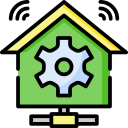Smart home technology has rapidly transformed modern living, weaving intelligent solutions into the fabric of our daily routines. From automated lighting and energy management to personalized security systems, the influence of these innovations is profound and far-reaching. By seamlessly integrating cutting-edge devices and systems into our homes, smart technology is redefining comfort, safety, convenience, and our overall quality of life. This page explores the various ways smart home technology is making a significant impact on how we live, manage our households, and interact with our environments.
Enhanced Home Security
Real-Time Monitoring and Alerts
Smart security cameras and sensors allow homeowners to monitor their property remotely at any time, from anywhere in the world. With high-definition video feeds and motion-activated alerts sent directly to smartphones, residents can stay informed about everything that happens around their home. This real-time access increases accountability, deters intruders, and enables immediate action in case of suspicious activity, greatly enhancing overall security.
Smart Locks and Access Control
The integration of smart locks has redefined how residents secure their homes and manage access. With keyless entry, biometric authentication, and remote locking abilities, homeowners can grant access to friends, family, or service providers without physical keys. These features not only add convenience but also improve security, as temporary or scheduled permissions can be managed with precision, reducing the risk of lost or copied keys.
Automated Response Systems
Modern smart homes can include alarm systems that automatically contact emergency services or trigger alarms when unauthorized access is detected. Integration with other smart devices, such as automated lights or sirens, can further deter intruders by simulating occupancy or drawing neighborhood attention. Such automated responses offer a proactive defense layer, providing enhanced protection compared to traditional security systems.
Intelligent Climate Control
Smart thermostats and climate control systems analyze user behavior and external conditions to optimize heating and cooling within the home. Through learning algorithms and connectivity with weather data, these devices adjust temperatures for comfort while minimizing energy use. Enhanced scheduling capabilities further enable residents to create efficient routines, ensuring energy is only used when and where it’s needed most.
Automated Lighting Solutions
The use of smart lighting can drastically reduce unnecessary power usage through automation and remote control. Occupancy sensors, daylight harvesting, and customizable schedules allow lights to operate only in occupied areas or adjust to varying levels of natural light. This leads to significantly lower electricity bills while still meeting the household’s lifestyle needs, making daily living more sustainable and cost-effective.
Appliance and Device Management
Smart plugs, energy monitors, and connected appliances enable real-time tracking and control of energy consumption throughout the household. Homeowners can remotely shut off devices that are not in use or set specific times for energy-intensive appliances to operate during off-peak hours. This granular level of management helps users make informed decisions, fostering long-term changes in consumption habits for both efficiency and savings.
Greater Convenience and Comfort
Voice-Activated Assistants
The integration of voice assistants like Amazon Alexa, Google Assistant, or Apple Siri has completely altered how people interact with their homes. With simple spoken commands, residents can control lights, adjust the thermostat, play music, or get answers to questions without having to lift a finger. This hands-free control is particularly valuable for multitasking, accommodating those with mobility challenges, and creating a truly effortless domestic experience.
Personalized Automation Routines
Smart home hubs and automation platforms empower users to design routines based on personal schedules and preferences. For example, a morning routine can gradually brighten lights, warm up the living room, and start brewing coffee all before residents rise. Such customization fosters a sense of luxury and well-being, as every element of the home environment can be synchronized to enhance the resident’s daily flow.
Remote Accessibility and Control
Smart home technology extends convenience beyond the physical boundaries of the house, granting homeowners control over their environment from anywhere via smartphones or computers. Whether adjusting the thermostat before arriving home or checking if the doors are locked while on vacation, this remote access offers peace of mind and flexibility. It eliminates the hassle of mundane chores and ensures the home is always prepared to welcome its residents.
